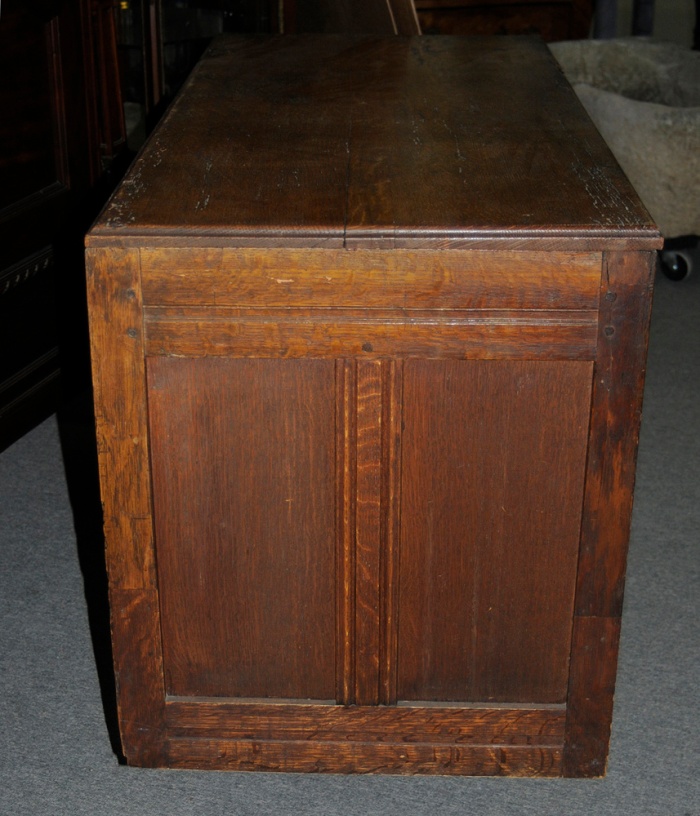By now, you know I am a big fan of this style of carved oak furniture. This chest is being offered at an auction in North Carolina, http://www.brunkauctions.com/lot-detail/?id=94982
It’s in pretty beat-up shape, lost its feet, top is trimmed and patched here & there, etc. But so what? The carving is all there. What fun. This is listed as attributed to the Mason/Messenger shops in Boston, but that’s a mistake. It’s Thomas Dennis from Ipswich, Massachusetts; 1660s-1700. It has never been published before in any of the numerous treatments on Dennis’ work…this one literally came out of the woodwork.

I noticed they have added a few more pictures from when I first saw it two weeks ago. These two show each end of the chest. Clearly one set is oak, with the ray-fleck pattern from the riven quartered stock. The first pair here seem very plain for riven, quartered oak. Now it’s really difficult to judge a piece by the photos; and these are snapshots rather than the good quality shots above..but if I had a chance to see this chest, I’d look at these end panels to try to understand why they are different from one set to the other. It almost looks like the figured set are sycamore/plane tree.
Someone will get a nice chunk of New England joinery history at a discount price. The condition will keep it from getting into the stratosphere. Me, I’ll have to carve my own – after the wainscot chair I have underway now.



Yeah, this really is a wonderful example of Dennis/ Devon carving, to bad about the feet. Since Dennis carved his stiles, would this be more difficult/expensive to restore than say a Savell chest who did not carve the legs of his work?
more difficult, no. but more expensive – of course. Just add carving! These stiles are the same as a chest at the Met in NY, and Chipstone I think. the pinwheel is positioned in the middle of the stile’s length. So this chest, like its relatives, could have had brackets under the front bottom rail.
but more expensive – of course
Yes, that figures. There are small traces of paint in the carving on this chest plus the background in the carving is smooth, not punched which makes me think it may have been painted like this Dennis chest from an earlier PF blog post.
https://pfollansbee.wordpress.com/2012/01/30/carving-a-wide-muntin/
Peter, I think I may have some detailed pics of this chest or one similar. Long story, but I saw one a family was trying to sell some 30 years ago in Virginia. Not sure where the are, but will try to find them.
Hope all us well,
Bill
Sent from my iPhone
I have seen pictures of underside and back. Unfortunately the chest’s lower rails are chopped and there is no way to determine if the chest had a drawer or not. Bottom is replaced. Further one mutin and a panel are replaced. The two on the side that look odd are replaced as well.
But Peter is probably right that the replaced panels are sycamore. I really can’t understand why people think it’s so hard to obtain quartersawn or riven oak. Even I could do it. I think I still have wedges from when I split an oak for Benno Forman in 1973. In this case a bit of the carving at the bottom of the front posts may have been lost. It’s not quite as compromised as the one that was sold in North Carolina a few years ago. The lid can be fixed. The till and till lid are there. The annoying replacements can be done over. The legs can be extended without obsessive-compulsive invisible splices. It is unfortunate that the evidence for brackets is compromised. Also that I’m blithering away about it without having a customer for it.
The plain panels do look a bit out of place, but it’s hard to tell anything from the photos. The figured panels, on the other hand, are pretty obviously oak. Sycamore rays are much smaller and more numerous. The appearance of the rays is pretty typical of quartersawn, rather than riven, oak. The panels may have been riven, but you can tell that the maker would have had to do a lot of hewing and planing if they were. The dot-like rays in the upper half of the panels indicate that the face of the panel is well out of the radial plane, whereas the more typical rays in the lower half are almost perfectly in the radial plane, showing that the planks from which they came had a twist in them. They appear to be bookmatched.
Well Peter, it’s being auctioned just after the carving class at Lie-Nielsen. Maybe there will enough students that you can pick this piece up….brings up a question, though. I know you study a lot of period pieces but do you have any of your own, is there a Follansbee Collection out there.
Alan